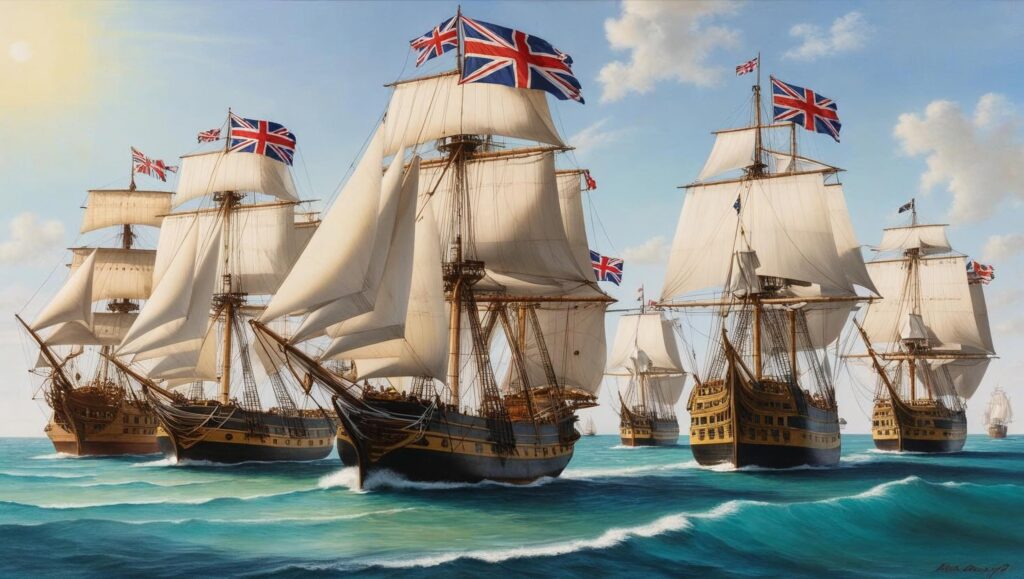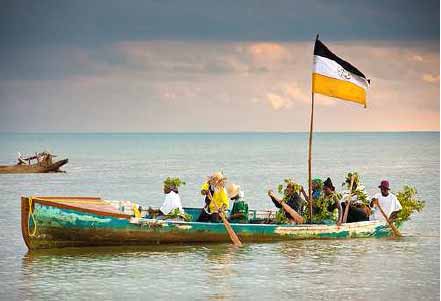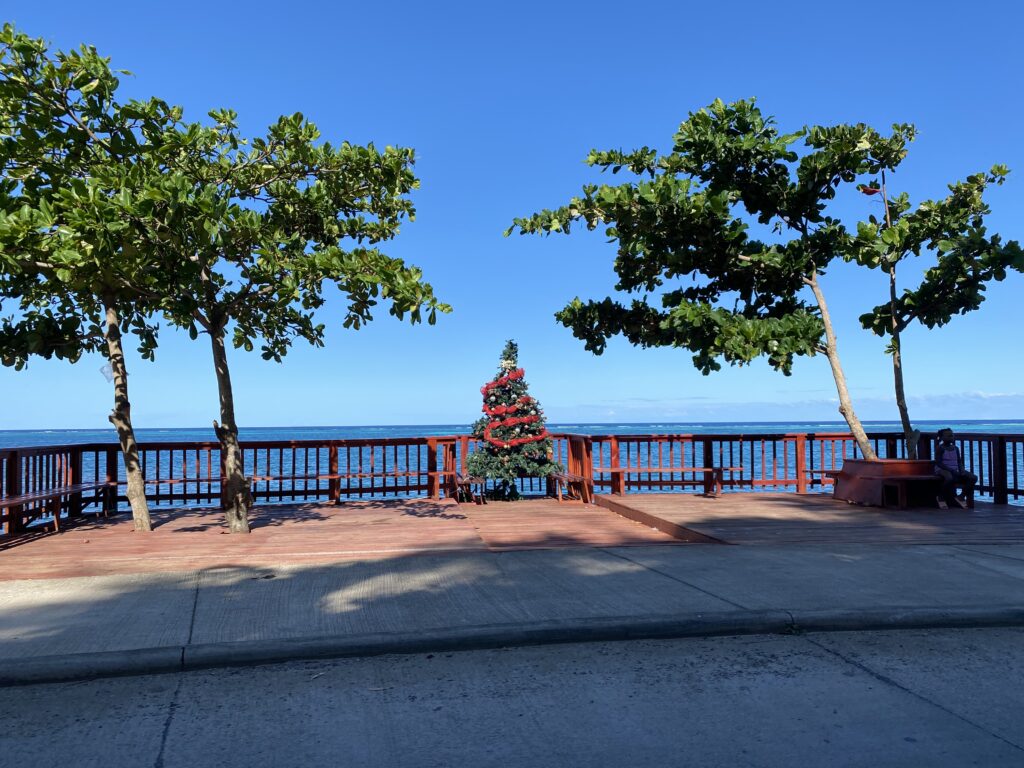Thousands of the proud Garifuna (Garinagu) people refused to be slaves on British plantations. However, after years of resistance, most were exiled by British colonists from their homeland on Yurumein and plunged into disease that ended in mass death. Those who remained were then exiled to the other end of the Caribbean.
On April 12, 1797, somewhere around 2,000 Caribs of the Garifuna people stand on the docks in Port Royal on the island of Roatan in the western part of the Caribbean ocean. Most are at a loss and in despair. Afraid. Exhausted after months of bad conditions including almost a month’s sailing from home. What will the future bring? They have been robbed of family members, property, land, freedom, and dignity. Should they just give up?
The year before, they had lost the battle for their own island of Yurumein, located in the eastern Caribbean. Christopher Columbus renamed this island to Saint Vincent when he discovered it on January 22, 1498 – on the anniversary of this saint. The British colonial power had cultivated the very fertile soil on the island – after a large immigration in 1763 and preferred that the Garifuna became slaves on their sugar plantations. But the colonial power faced resistance. A long and tenacious war was waged against the natives and in 1795 the British decided to try to end the conflict by deploying larger military forces to the island. A number of African slaves were fighting on the side of the British. To the colonialists the Caribbeans are seen as primitive and without rights.
The French had tried to colonize the island earlier but the British were about to dominate, so the French chose to fight on the side of the Garifunas for a period before abandoning them. The murder of the legendary Garifuna Chief Joseph Chatoyer creates a turning point in that – this demoralizes large parts of the native population and they eventually choose to surrender. Also because the Brits had burned down their houses and crops.
The British made the Garifunas prisoners and in order to get rid of them immediately, just under 5,000 of them are exiled to the uninhabited island of Baliceaux just south of Saint Vincent, while they decided what to do with them. This island is around 4,000 m2, it is completely impossible to grow anything there and there is a critical shortage of fresh water. The British provide supplies but it is not sufficient. In addition, disease is rampant among the Garifuna, most likely yellow fever or typhus. They die at a high rate and the survivors refuse to bury the dead. In December 1796 alone 950 of them die, among them were thirteen British soldiers that kept watch on the island.
The British realize at some point that this is going terribly wrong, although they believe that the Garifunas have themselves to thank for much of the misery. They could have agreed to become slaves on the plantations and let this desire for independence go. In addition, the British determined that the disease had already broken out among the Garifuna before they surrendered. Historian Earle Kirby believed that the smell from the corpses of the rapidly dying population drifted over to Saint Vincent and became unbearable for the British residents.
They then decided to exile the Garifunas to the island of Roatan off the coast of Honduras, which at the time was dominated by the Spanish. A flotilla of 8 ships, including several heavy warships of the man o’war type, led by “HMS Experiment”, loads up the remaining Garifunas, and on March 9, 1797, 2,248 of them get their last glimpse of their homeland before they disappear beyond the horizon. Yurumein – was where they had been free and once lived in peace. It had been a place where Africans who escaped from slavery or survived slave shipwrecks had been well received by the indigenous peoples of Arawak and Kalinago. They allowed themselves to fraternize and eventually became part of the proud people of Garifuna.
Once – they had been masters of their island country and the sea around them. Now, everything they had was gone. It was sad but they were still relieved to be transported away from Baliceaux which to this day is a barren place, home only to a small number of turtles and pastures for cows. Now they were about to embark on a journey into foreign lands and little did they know what awaited them.

The island of Roatan is only a few days’ sail away, but the trip takes over a month and becomes dramatic for some of the prisoners. They sail via the island of Grenada to take on fresh water and then to Port Royal in Jamaica for more supplies and ship repairs, which takes a couple of weeks. The ship “John and Mary” is so battered that they have to transfer the Garifuna to other ships.
Two of the British ships are hijacked by the Spanish off Roatan’s neighboring island of Guanaja, including the merchant ship “Prince William Henry”, with three hundred Garifuna on board. They are sent to the port city of Trujillo on the mainland of Spanish Honduras.
On April 11 1797, Roatan appeared on the horizon, and the following day the flotilla sailed into Port Royal on the southeast side of the island. The commander of the Spanish fort there surrenders, probably due to the strong British military presence in the arriving group. By this time the number of Garifunas is reduced to 2,026. The British had brought what they themselves calculated to be sufficient supplies for 6 months for the Garifuna and included food, livestock, and fishing equipment. But the exiles believe that it is not sufficient and the British went back for a new round of supplies, but upon returning to the island most of the Garifuna have disappeared.
The British had hoped that the Garifuna could defend the island against the Spanish, but 1,465 of them surrendered to the Spanish in return for transporting them to the Honduran mainland. Their homes have already been taken from them and they think it’s too cramped on Roatan.
On the mainland, they are put to work preferably as soldiers and fishermen. Land is also cleared so that the women can farm both for themselves and for selling. As well as feeding themselves, this also contributes to large parts of the migrating Spanish coastal population being saved from famine. They had no knowledge of living and producing food in tropical regions, and received important knowledge from the Garifunas.
Only 206 Garifunas remained on Roatan. They mainly stayed to the north of the island and established themselves in the areas on the northeast coast, with their center at the place they call Rubadan, which is today the village of Punta Gorda. There is no link between the two names. Punta Gorda is an attempt to translate the Garifuna term “Duburugu” (fat point) into Spanish, which was the term for a landmark, that refers to a pile of stones that to this day stretches from the hillside down to the beach in the village.
Immediately after the unloading of the Garifuna people in Port Royal, the British flotilla sailed to the mainland port city of Trujillo to take back the hijacked merchant ship “Prince William Henry”. The whereabouts of the other hijacked ships are uncertain. The British started their attack with a somewhat useless bombing of the harbor. But after a truce and negotiations, they finally get the ship released with its prisoners included.
On the way back to Roatan, the British spot enemy ships, and the escort feels outnumbered and heads north towards Nova Scotia, Canada. The “Prince William Henry” is suddenly on his own and eventually ends up shipwrecked on the Mesoamerican reef that surrounds Roatan where the Garifuna who is still on that ship, perish.
In the following years, the Garifuna communities spread out along the coast of what eventually became independent Honduras, British Honduras that is now Belize, and Guatemala. They most often establish themselves in extended family groups, led by a “captain” as they were organized at home on Yurumein. They prefer to live in seclusion, close to the sea for access to fishing and trade. In addition, they gravitate towards paid work such as cutting mahogany trees, soldiering, agriculture and trade. Or as sailors and as workers on fruit and sugar plantations.
The Second World War also provides job opportunities in the United States and some emigrated there.
Not everyone left St Vincent in 1797. There was still a significant number hiding in the mountains of the island. From there they carried out revenge actions against the British establishments. Their attacks were often characterized by brutal killing and maiming. But eight years after the great deportation, the last of them surrender to the British colonial authorities. Many eventually became slaves on the British plantations.
One of their traditional dances reproduces some of the tactics that the Garifuna used on St Vincent. When the British came, the warriors dressed up as women and attacked them off guard. The dance takes place with men in women’s clothes.

Today, most Garifunas are Catholics, at least in name, something that was almost forced upon them as the region was dominated by Spain. Some call the British’s careless handling of the Garifuna at the time genocide. If history is to be believed, it is not difficult to see why many people felt that way.

Because today the Garifuna are numerous and they have managed to keep the traditions by consciously cultivating the culture which is strongly characterized by the African one, which holds them together as a people.
The director of the Garifuna Cultural Center in Punta Gorda, Audrey Flores, does not see this deportation today as a curse but rather a blessing.
“We are a large, yet tightly-knit community spread over a large area, with a unique culture that consists of language, music, clothes and dance. We show the world that we are proud and take care of our culture,” says Flores proudly.
They are very proud of their ancestry, especially the resistance they waged on Yurumein, symbolized by the recognition of their warlord Joseph Chatoyer.
But in some areas, they are still oppressed and persecuted. Why? And what did the British themselves think of this deportation at the end of the seventeenth century?


The Garifuna Cultural Center in Punta Gorda Roatan is temporarily closed.
Literature:
“Black Caribs, Garifuna Saint Vincent Exiled People” – Tomás Ávila
“The Black Carib Wars” – Christopher Taylor
